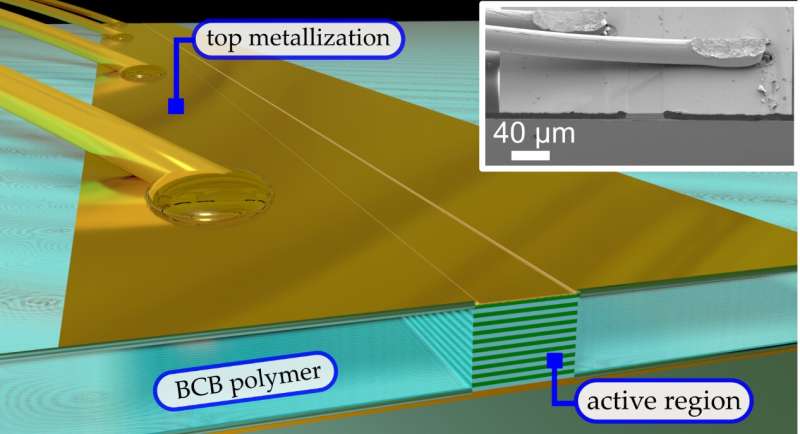
Integrated photonics extensively uses on-chip optical elements such as sources, splitters, modulators, and high-confinement waveguides embedded in a planar platform to efficiently process and route optical signals. There is a growing interest in integrated Mid-IR and THz photonics for telecommunications and sensing. In the THz frequency range, a prominent candidate for source integration is the THz quantum cascade laser.
Recent advances in the high-temperature operation of these devices, combined with their frequency agility and the possibility to operate as frequency combs and high-speed detectors, make them highly appealing as crucial building blocks for THz photonics. Some of the previous approaches to THz integration include hybrid plasmonic waveguides, monolithically integrated THz transceivers, coupled cavity devices, and, most recently, devices integrated on silicon.
In a new paper published in Light: Science & Applications, a team of scientists led by doctoral student Urban Senica and Professor Giacomo Scalari from ETH Zurich developed a novel integrated photonic platform.
In more complex photonic systems, some crucial features for laser integration are reducing electrical consumption and the efficient coupling to low-loss passive waveguides. The researchers proposed a new platform for integrated THz photonics that allows signal propagation with passive elements and coherent source integration for broadband sensing and telecommunications.
They leveraged the presence of a common metallic ground plane, which was chosen to demonstrate the integration of several active and passive THz photonic components onto the same semiconductor platform. This approach allows for efficient signal processing at THz and R.F. frequencies.
The researchers focused on broadband and frequency comb devices. They highlighted improved performance in several crucial figures of merit, such as dispersion, R.F., and thermal properties. Their model demonstrated the co-integration of active and passive elements on the same photonic chip. The basic building block is a high-performance planarized double-metal waveguide with an extended top metallization. A similar waveguide has already proven to be very efficient for THz and microwave applications.
In the context of THz frequency combs, the researchers showed that control over transverse modes is essential to obtain a regular and flat-top comb spectrum, mainly with a reduction of the ridge lateral dimensions. However, the width cannot be arbitrarily small since the waveguides are connected by wire bonding directly on the top metallic cladding. It inherently limits the effective ridge width to the dimensions of the bonding wire patch. It makes devices with ridges of 50 µm or below challenging to contact and prone to failure. Bonding directly on the active region can introduce defects, increasing the waveguide losses and non-intentionally selecting specific modes, potentially compromising the long-term performance of the device and its spectral characteristics.
These issues are solved within the team’s planarized platform. Placing the bonding wires on top of the extended top metallization over the passive, BCB-covered area prevents the formation of any defects or local hotspots on top of the active region. It enables the fabrication of very narrow waveguides well below the bonding wire size.
The narrow waveguide width can be employed as an efficient selection mechanism for the fundamental transversal lasing mode and is also beneficial for heat dissipation and high-temperature continuous wave (C.W.) operation. Moreover, the extended contact facilitates a lateral heat flow and eases the heat extraction as in a radiator scheme. It results in an improved measured maximum operating temperature of the planarized devices.
More information: Urban Senica et al, Planarized THz quantum cascade lasers for broadband coherent photonics, Light: Science & Applications (2022). DOI: 10.1038/s41377-022-01058-2
Journal information: Light: Science & Applications
Provided by Changchun Institute of Optics, Fine Mechanics And Physics

